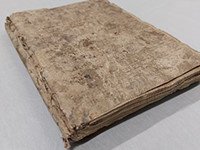 As the Conservator at Surrey History Centre, I have the privilege of working on some amazing treasures held within our archive. We have a lengthy list of items in need of conservation, but every now and then an item of particular interest will be prioritised for treatment, especially if there is a risk of further damage or loss of information.
As the Conservator at Surrey History Centre, I have the privilege of working on some amazing treasures held within our archive. We have a lengthy list of items in need of conservation, but every now and then an item of particular interest will be prioritised for treatment, especially if there is a risk of further damage or loss of information.
An early 16th century volume of manuscript and printed notes recently came into the conservation studio in need of attention. Our Senior Archivist had noticed that several pages had become damaged and there was a risk of losing parts of the text. Researchers had requested the item, so there was a need to stabilise the pages so the contents could be carefully viewed.
 The sections of the binding were made of varying sizes of paper, and include manuscript notes, as well as a printed section containing a poem entitled 'The Parlyament of Devylles.'
The sections of the binding were made of varying sizes of paper, and include manuscript notes, as well as a printed section containing a poem entitled 'The Parlyament of Devylles.'
The handwritten notes cover topics including grammar, Latin vocabulary, philosophy and astronomy, medical prescriptions, a copy of the will of William Bradwall of Horton (1523), formulary of deeds and other legal documents.
The sections were sewn together in a random fashion, and then wrapped and sewn in a piece of parchment that had previously been used as a sheet of music. The front cover of the limp binding is fragile but still intact, however the back cover has suffered damage from damp, pests, and poor handling.
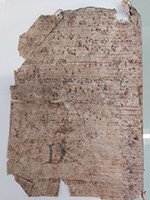 When deciding treatment, I first assess the condition of the item and start a detailed report documenting the approach with before and after photos and the results of any tests on materials and pigments. As the original sewing was intact, a decision was made in agreement with the County Archivist to approach repair using minimal intervention to stabilise the document while retaining the character of the binding and the original sewing and materials.
When deciding treatment, I first assess the condition of the item and start a detailed report documenting the approach with before and after photos and the results of any tests on materials and pigments. As the original sewing was intact, a decision was made in agreement with the County Archivist to approach repair using minimal intervention to stabilise the document while retaining the character of the binding and the original sewing and materials.
The main concern was the damage caused to the top edges of parts of the text block which had been sliced across the top at some point, risking loss of information. There were mechanical tears from poor handling. The cover also needed consolidation, especially the damaged back cover.
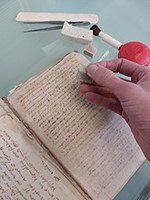 I started the treatment by carefully surface cleaning the entire binding using soft brushes, air, and specialist cleaning sponges.
I started the treatment by carefully surface cleaning the entire binding using soft brushes, air, and specialist cleaning sponges.
I decided to repair the damaged paper sections using remoistenable Japanese tissue. This technique reduces the amount of moisture applied to the paper to prevent distortion and tide marks by dampening adhesive backed Japanese tissue to reactivate the adhesive without the need to wash the paper. The repairs are dried and flattened in a supported position using release paper, blotting paper, Perspex and small weights.
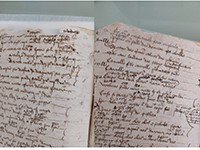 Once the text block has been repaired where needed, I will consolidate the damaged parchment binding cover using goldbeater's skin which will be applied using gelatine. Goldbeater's skin is a very thin, transparent material made from cattle intestines, and will provide a sympathetic repair to strengthen the weakened parchment sections and adhere any torn pieces.
Once the text block has been repaired where needed, I will consolidate the damaged parchment binding cover using goldbeater's skin which will be applied using gelatine. Goldbeater's skin is a very thin, transparent material made from cattle intestines, and will provide a sympathetic repair to strengthen the weakened parchment sections and adhere any torn pieces.
Once all the damaged pages have been repaired and the cover has been stabilised, the binding will be packaged carefully in a four-flap folder and then boxed to ensure the document is protected from further damage. Use will need to be restricted and a book support will be used to prevent damage from handling, and to ensure this document is preserved for many more centuries to come.
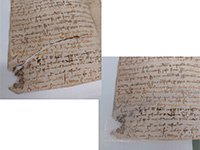 In the future, if time and resource allow, there may be an opportunity to conduct full conservation on this item by washing and rebinding each section, but it will be important to retain the integrity and charm of the original item. 19th and 20th century repairs sadly saw the loss of many original bindings, but thankfully conservation techniques and approaches are now more sympathetic to the history and character of these fascinating historical documents.
In the future, if time and resource allow, there may be an opportunity to conduct full conservation on this item by washing and rebinding each section, but it will be important to retain the integrity and charm of the original item. 19th and 20th century repairs sadly saw the loss of many original bindings, but thankfully conservation techniques and approaches are now more sympathetic to the history and character of these fascinating historical documents.
See also
Images
Select image to view a larger version.
- Whole binding of the notebook (reference LM/1327/2)
- Printed page from the notebook
- Back cover of the notebook
- Cleaning the pages of the notebook
- Repair of the top section of the notebook, before and after
- Conservation of the torn section of the notebook, before and after

